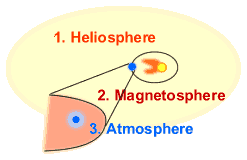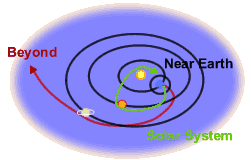The Sun is located in the outskirts of the Milky Way, about 30,000 light years from its center. Although we would have to travel about 260,000 times the distance between the Sun and Earth, i.e. 260,000 AU (1 Astronomical Unit [AU] = distance of the Earth from the Sun) to the neaterest star system (with Alpha and Proxima Centauri), this vast space is not entirely empty. It contains interstellar gas, in our immediate neighborhood with a density of about 0.25 particles/cm3, which is actually a mixture of neutral and ionized gas or plasma. This plasma is extremely dilute compared with the air we breathe, which contains about 4 x 1019 molecules/cm3 . Why then would we ever be interested to study our neighborhood, if it is almost empty and any star system is so far away? There are three compelling reasons for such a venture:
1) It is a matter of comprehension: Space Weather, which impacts severely our technology and our near Earth environment, is determined by the activity cycle of the Sun and its violent events, such as solar flares or coronal mass ejections, by particle acceleration and transport in the space between the planets (interplanetary space), and by the intrusion of cosmic rays from our Milky Way galaxy.
In order to master predictions of Space Weather as we have come to be accustomed to with weather predictions every day, we need to understand the forces that drive events of solar activity and the environment that they act in, i.e. the heliosphere.
 Actually,
the heliosphere is the first defense in the three-layer shield system
of the Earth against high-energy galactic cosmic rays, which consists of 1) the
heliosphere with the Sun's magnetic field carried out by the solar wind; 2) the
Earth's magnetic field (magnetosphere), and 3) the Earth's atmosphere. The solar
wind, which expands radially from the Sun at supersonic speed, blows a huge cavity
- the heliosphere - into the surrounding interstellar cloud, filling it with
solar material and magnetic field. The plasma component of the interstellar gas
is kept outside the heliosphere. By balancing the solar wind ram pressure, which
is easily measured, against the pressure of the surrounding cloud, the size and
shape of the heliosphere is determined. In this way, the conditions in the surrounding
interstellar cloud determine the boundary of the heliosphere.
Actually,
the heliosphere is the first defense in the three-layer shield system
of the Earth against high-energy galactic cosmic rays, which consists of 1) the
heliosphere with the Sun's magnetic field carried out by the solar wind; 2) the
Earth's magnetic field (magnetosphere), and 3) the Earth's atmosphere. The solar
wind, which expands radially from the Sun at supersonic speed, blows a huge cavity
- the heliosphere - into the surrounding interstellar cloud, filling it with
solar material and magnetic field. The plasma component of the interstellar gas
is kept outside the heliosphere. By balancing the solar wind ram pressure, which
is easily measured, against the pressure of the surrounding cloud, the size and
shape of the heliosphere is determined. In this way, the conditions in the surrounding
interstellar cloud determine the boundary of the heliosphere.
2) The surrounding cloud material represents a sample of today's interstellar
matter in our Milky Way Galaxy from which stars and planetary systems form. In
the case of the Sun and its planets this occurred about 4.5 billion years ago,
i.e. its composition was frozen in with the conditions in the galaxy at that
time.  Differences in the composition of these two samples of galactic matter
tell the story of the evolution of matter in the galaxy, as heavy elements are
constantly added to the ambient material by dying stars, while cosmic matter
was rather simple right after the Big Bang, as it only contained 75% H and 25%
He, with just a few sprinkles of Li. All heavy elements that are necessary ingredients
for planets and all living beings, including ourselves, were only formed inside
the nuclear ovens of stars and redistributed by fierce stellar winds and supernova
explosions.
Differences in the composition of these two samples of galactic matter
tell the story of the evolution of matter in the galaxy, as heavy elements are
constantly added to the ambient material by dying stars, while cosmic matter
was rather simple right after the Big Bang, as it only contained 75% H and 25%
He, with just a few sprinkles of Li. All heavy elements that are necessary ingredients
for planets and all living beings, including ourselves, were only formed inside
the nuclear ovens of stars and redistributed by fierce stellar winds and supernova
explosions.
 3) Finally, we should be reminded that no exploration into unknown territory
has ever come back without any new and surprising discoveries.
3) Finally, we should be reminded that no exploration into unknown territory
has ever come back without any new and surprising discoveries.
How do we know anything about our neighborhood? Admittedly we have not been able to send any space probes outside our solar system, and the gas and plasma outside appears to be much too dilute that it be noticed, we might think. However, nature has been kind to us to send some messengers to our front door step, which we just have to learn to decipher.